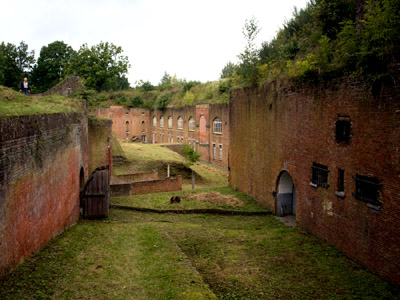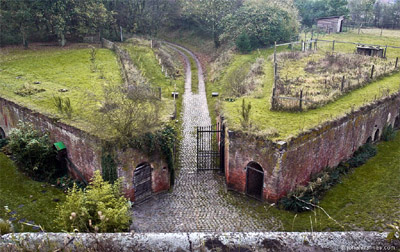 |
Citadel Diest
Diest, Belgium
|
|
 |
Constructed: 1830
Used by: Belgium, Germany
Conflict in which it participated:
None directly, but occupied by the Nazis in the Second World War
|
Belgium is known as "Belgium" thanks to the Belgae, a mix of Germanic and Celtic peoples who lived in the northernmost part of Gaul (which comprised most of Europe west of the Rhine) before the Roman invasion of 100 BC.
Most of Belgium's history reads like a Who's Who of conquery European powers that all took turns possessing it, until 1830 when it finally became an independent nation by separating itself from the Netherlands.
|
 |
|
|
Priority #1 for the fresh new nation was to defend itself from the slimy tendrils of its old oppressor. Diest is located to the northwest of Belgium's capital of Brussels, which actually makes it a kind of weird place to defend the city from the Netherlands, which is directly to the north of Brussels. If the fiendishly clever Netherlandian warmongers planned a sneaky circular route to the east around Antwerp, however, they might happen upon Diest and be deterred by a well-placed starfort. Maybe?
|
To be fair, Diest had been besieged, looted and/or destroyed on numerous occasions in the 16th, 17th and 18th centuries. Expecting much of the same, a series of fortifications were built in Belgium at varying distances from Brussels after Belgium's independence, but the only major fortification that remains, at least in somewhat decent condition, is Citadel Diest.
Belgium's first king, Leopold I (1790-1865), obviously felt that Diest was directly on the route of somebody's intended onslaught, because the town was heavily fortified between 1837 and 1853: The most un-starforty fort ever, Fort Leopold, was built to the north of Diest, and the western side of the town was completely fortified. This would seem to suggest that Germany was considered to be at least as much of a threat to Diest as were the Netherlands.
|
 |

The magic of Citadel Diest's first line of inner defenses: An attacker might make it through the main gate (wooden door at left), only to be confronted with a closed inner fort! Of course the attacker would then just look a little to the left and say, "Hey, let's just climb through those dumbass windows!"
|
|
|
 |
If Leopold suspected that Germany was the more likely invader it would have been prescient indeed, because it was Germany that invaded in a most comprehensive manner at the start of the First World War (1914-1918).
By this time the fortifications of the previous century were of course obsolete, and if the German army did roll through Diest, the Citadel and Fort Leopold likely just silently sat there and watched it happen, lest they be instantly pounded into oblivion by modern artillery.
The Citadel of our current interest was slightly more useful during the Second World War (1939 - 1945), though unfortunately for the wrong side.
|
|
|
The Nazis moved in and installed a training facility for the Nationalsozialistische Kraftfahrkorps, the National Socialist Automotive Corps. This was a paramilitary transport organization that trained locals to drive Nazi stuff around. As unpleasant as any Nazi involvement with the Citadel may be, at least folks weren't being actively slaughtered there.
The Citadel was kept in shape after the war, and from 1953 to 2011 it served as the home base for Belgium's First Parachute Battalion. Since 2011, the authorities of Diest have been scratching their heads over exactly what to do with the fort and its environs, but seem to have come to the conclusion that some sort of annex to the city's hospital should be built near the Citadel.
Today the Citadel can be visited as long as one secures the services of a guide for €50 and if the Paratroopers have been alerted ahead of time, as they appear to still be one or two deadly paras lurking in the vicinity.
|
Named for King Leopold I, Fort Leopold was built sometime during the period of frantic activity in and around Diest that lasted from 1837 to 1853. Diest was fortified to a high level of readiness for the Netherlandian invasion that was anticipated but never transpired.
By the middle of the 19th century, the technology of artillery had advanced to the point that the starfort was no longer considered the optimal design for a fort. With guns able to accurately reach for miles, the time of mutually supporting, pointy bastions was over.
|
 |
|
|
Fort Leopold is an example of what came next, the Artillery Fort. Most of this type of fort were built in Europe from the middle of the 19th century into the 20th, as financial constraints in the US led to the upgrade of existing fortifications by adding batteries in and around starforts that were built mostly in the early 1800's. European monarchs, however, liberally littered the area around their major cities with plenty of ugly Artillery Forts, very few of which ever successfully defended what they were intended to defend when war finally did hit Europe in a meaningful fashion at the start of the 20th century. Fort Leopold is not to be confused with Leopoldov in Slovakia, which was named after a different King Leopold I, this one of the Holy Roman Empire, who lived from 1640-1705.
 A shot of Fort Leopold's weird little front gate. A shot of Fort Leopold's weird little front gate.
There's obviously some small-scale farming going on in the fort these days! |
 |
|
|
|
|
|
|
|
 |




